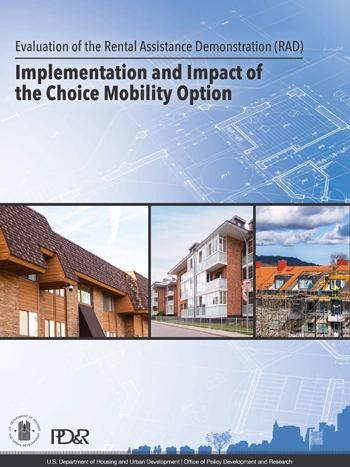Evaluating the RAD Choice Mobility Option, Part 3: PHA and Property Outcomes

This is the final article in a three-part series discussing the findings of the 2023 report "Evaluation of the Rental Assistance Demonstration (RAD): Implementation and Impact of the Choice Mobility Option." This article discusses the experiences of PHA staff and property owners with the Choice Mobility option. The first article reviewed findings about the prevalence of Choice Mobility use among eligible RAD residents, and the second article discussed the experiences of residents.
A central goal of the Rental Assistance Demonstration (RAD) program is to support the long-term preservation of affordable housing by allowing public housing properties to replace their conventional public housing support with project-based voucher or rental assistance support. Converted public housing properties benefit from increased access to financial tools that are commonly available to other affordable housing projects, such as low-income housing tax credit financing. In creating RAD, HUD also included the Choice Mobility option, in which residents of RAD-converted properties can request a tenant-based (rather than project-based) voucher that they can use to move to a housing unit that better suits their needs. As a result, Choice Mobility indirectly affects unit turnover (the period between a tenant leaving a rental unit and a new tenant moving in) and maintenance costs at RAD-converted properties as well as the demand for tenant-based vouchers at public housing agencies (PHAs).
To understand the property-level and PHA-level effects of Choice Mobility, researchers collected data from public databases and conducted surveys of and interviews with PHA staff and property owners and operators. Researchers sent the Choice Mobility survey to 339 PHAs participating in the RAD program, and 211 of them (62 percent) responded. The PHA survey asked questions about Choice Mobility requests, use, and the availability of vouchers to meet the requests in 2019. The survey also asked about the effect of Choice Mobility on unit turnover and property management responsiveness. As detailed in the second article of this series, the resident survey asked about the physical condition of units, comparing Choice Mobility users with residents who stayed at the RAD property.
One research question concerned the impact of Choice Mobility on PHA voucher programs and the administration of waitlists. Because HUD does not grant new vouchers for Choice Mobility, PHAs place requesting residents on existing housing choice voucher (HCV) waitlists and use turnover vouchers to meet the demand. Those on the waitlist who request Choice Mobility have priority over other families and generally are the first to receive turnover vouchers. In a 2019 study of the RAD program, researchers found that many PHAs believed that Choice Mobility complicated the management of their RAD conversion process and voucher programs. This new study found that most RAD PHAs (72 percent) were able to fulfill Choice Mobility requests. Although PHAs are permitted to place discretionary limits on the Choice Mobility option, most PHAs were able to meet Choice Mobility voucher requests without reaching their limit because of the low number of requests. According to the survey, only 5.7 percent of eligible RAD residents requested a Choice Mobility voucher. However, the study also found that a sizable minority of PHAs (28 percent) reported not having sufficient vouchers to fulfill Choice Mobility requests because the supply of vouchers is limited. The researchers could not determine whether Choice Mobility requests impacted the time spent and composition of other families on the HCV waitlist — only that the share of Choice Mobility requests in the waitlist was very small (approximately 0.7 percent). The study notes, however, that since the number of turnover vouchers is limited and waitlists move slowly, even small numbers of Choice Mobility users could slow other families' access to vouchers.
A second research question concerned the impact of the Choice Mobility option on properties. An increase in Choice Mobility use could increase RAD unit turnover, potentially interrupting rental revenue, increasing maintenance costs to prepare units for new tenants, and requiring additional staff capacity. On the other hand, the Choice Mobility option also could make property managers more responsive to residents. The study found little evidence that Choice Mobility has led to higher turnover at RAD-converted properties when the option initially becomes available. Only 13 percent of PHAs reported that the Choice Mobility option caused higher turnover at some but not all properties, and 7 percent reported that it caused higher turnover at all properties. PHAs did not believe the Choice Mobility option affected overall property management responsiveness. The resident survey found similar levels of satisfaction with unit physical condition among Choice Mobility users and residents who stayed at the RAD property.
These insights indicate that Choice Mobility has not negatively impacted the voucher program or properties. Study authors described directions for future research, including better tracking of Choice Mobility requests and usage as well as closer monitoring of the impact of Choice Mobility on overall PHA waitlists and wait times.
